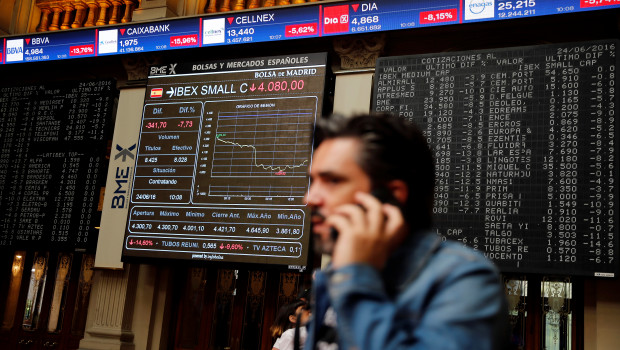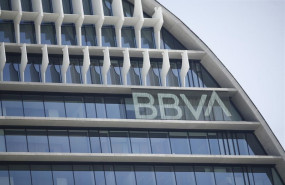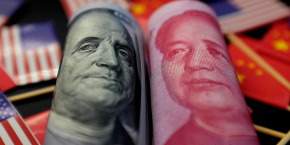The Ibex rises 1.4% and regains the 8,800 boosted by Santander and BBVA
The market celebrates China’s weakening of the yuan

New rebound session for European stocks after the earthquake caused by the escalation of trade tensions between US and China and the decision from the Popular Bank of China to let the yuan fall below 7 yuans per dollar. The stock markets have extended the Wednesday rebound (Cac: +1,8%; Dax: +1,3%; Ftse 100: +0,9%; Ftse Mib: +1,1%) supported by the Chinese central bank that has weakened its currency on Thursday less than what was expected. The Ibex has risen 1.4% and has closed in daily highs at 8,838 points thanks to a push from Santander (+ 2.2%) and BBVA (2.5%).
IBEX 35
11.711,800
-
0,47%55,20
- Max: 11.767,60
- Min: 11.679,60
- Volume: -
- MM 200 : 11.125,61
Green has been present in most values of the Ibex but the ones that stand out are Ence (+4.8%) and Arcelormittal (+4.5%). These values were offset by Red Eléctrica that has fallen 0.75%.
On the business front, IAG has risen 1.5% after announcing that it transported 67.8m of passengers in the first seven months, which implies a rise of 5.7% compared to the year-ago period. The shares of the airlines rise, and helped by the fall in oil today.
Arcelormittal is one of the stars on Thursday as it was once again one of the worst values of the selective on Wednesday due to the China-US conflict.
With the conflict still needed to be resolved, the market will look for reasons to rise in the decision of the Chinese central bank to place the average daily anchor at 7,0039 yuan per dollar. Despite being the weakest since April 2008, it is below what the market expected: 7.0205 per dollar, which convinces investors that the Chinese monetary supervisor has not fully engaged in a currency war.
In addition, US President Donald Trump decided to move China's focus away on Wednesday and put it back on the US Federal Reserve (Fed). "Our problem is not China ... it is the Federal Reserve ... they should reduce rates more," he published on his Twitter account, from where he again pressed the president of the agency, Jerome Powell, to follow the trail of other banks central and lower rates more.
TECHNICAL ANALYSIS
Without the knowledge of the closing of the weekly candle, "the truth is that we can be somewhat more optimistic than the last days." Especially, if this Friday it manages to continue rebounding hard. "Well, somehow the price could be drawing us a small 'hammer' from the support area of the 61.8-66% Fibonacci adjustment / retracement of the whole rise since the December lows," explained the technical analyst of Bolsamanía, José María Rodríguez.
That said and in the short term, "the next zone of resistance is found at 8,900 points", before support (June minimums). "In any case," the control areas are much clearer in European indexes than in our Ibex, "especially since the latter is much weaker than its brothers."
Thus, we have the European indexes "in reaction phase, or what is the same by adjusting the significant falls of the last two and a half weeks (of 10% for the Dax) and where we have to look at this week's minimums ".
So without following the current rebound (which can continue for several sessions / weeks) "the prices will pierce the weekly minimums", important bearish formations would be confirmed that would be, in theory, the prelude to a new whiplash of a certain intensity .
Summarizing, "we are in rebounds or reaction phase, nothing more. But in case the flies, we will closely monitor the minimums of this week in the European indexes," concluded the expert.
UNITED STATES AND ASIA
Despite everything, Wall Street managed to close positive yesterday and start this day in positive aswell. In the same way, Asia has finished this Thursday with increases. Shanghai and Shenzhen have risen 1%, while in Hong Kong, the Hang Seng has done 0.5%. The Nikkei has advanced 0.37%, the South Korean Kospi 0.57% and the Southeast Asian parks 0.5% on average. In the Pacific, the NZX50 in New Zealand has continued with increases of 0.8%, following Wednesday's decision by its central bank to cut rates by 0.5%. The ASX200 has advanced 0.75%.
The attention also goes to commodities. Gold continues its rally and exceeds $ 1,500 this Thursday, after reaching a maximum of $ 1,500 an ounce on Wednesday. Oil bounces (WTI: + 1.9%; Brent: + 1.1%) after closing this Wednesday with 5% drops.


